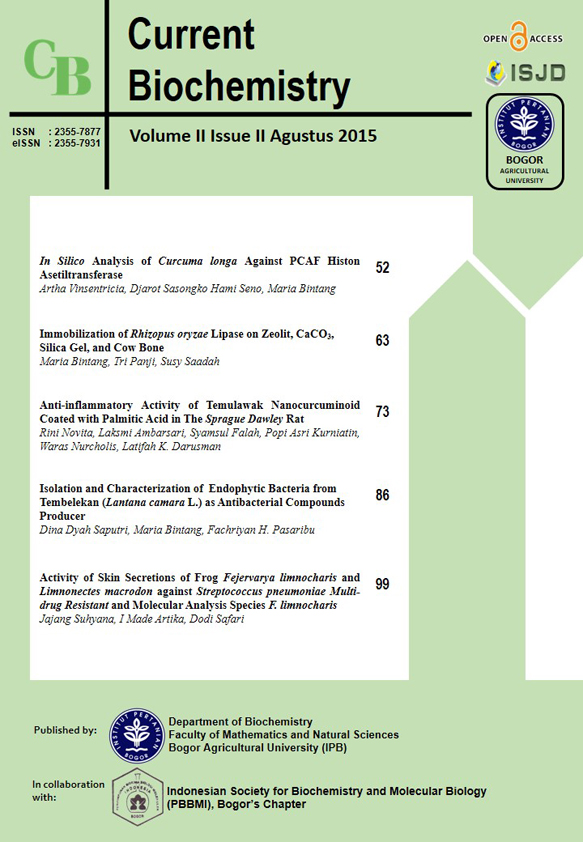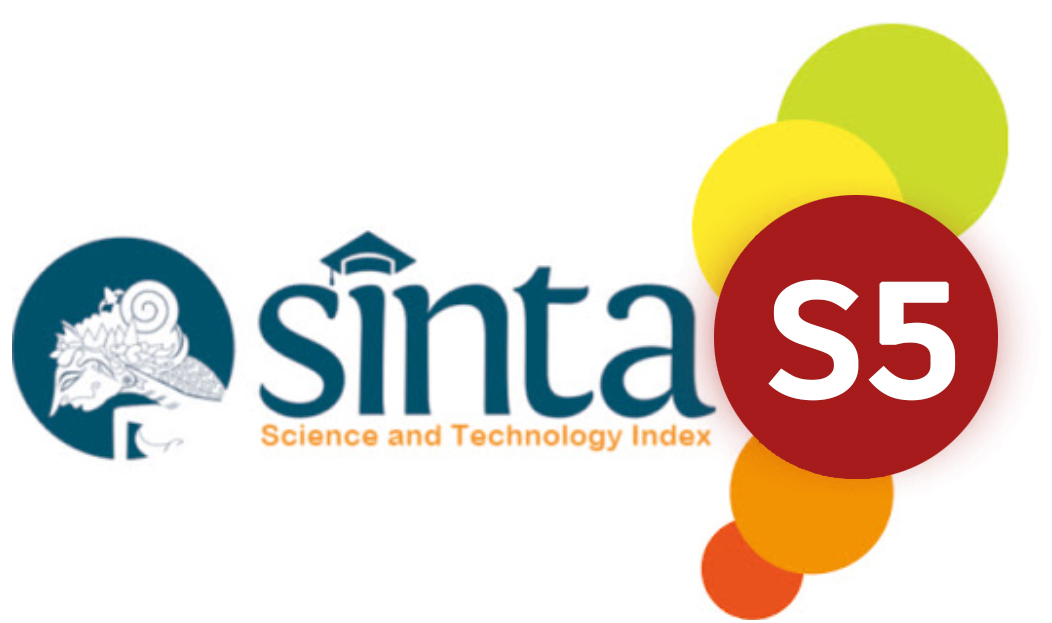Activity of Skin Secretions of Frog <i>Fejervarya limnocharis</i> and <i>Limnonectes macrodon</i> against <i>Streptococcus pneumoniae Multidrug Resistant</i> and Molecular Analysis of Species <i>F. limnocharis</i>
Abstract
Indonesia has about 450 frog species which is approximately 20% of frog species in the world. Among frog species found in Indonesia are Fejervarya limnocharis dan Limnonectes macrodon belonging to family Dicroglossidae. Frog skin secretion is considered to have a potency to be used as an alternative source of antibacterial agent against Streptococcus pneumoniae multidrug resistant (MDR). The aims of the present study were to analyze antibacterial activity of skin secretions of F. limnocharis and L. macrodon against S. pneumoniae multidrug resistant (MDR) and conduct molecular phylogenetic analysis of the frog used to ensure classification of frog species. The release of skin secretion was stimulated using epinephrine injection. Antibacterial activity of the skin secretions was tested using the well and paper disc methods. Results showed that skin secretions of F. limnocharis have antibacterial activity against S. pneumoniae multidrug resistant (MDR) SPN1307. The activity, however, was lower compared to that of chloramphenicol in both well and paper disc methods. On the other hand, skin secretions of L. macrodon failed to inhibit the growth of S. pneumoniae multidrug resistant (MDR) SPN1307. Molecular phylogenetic analysis was carried out on F. limnocharis based on DNA sequence of a partial fragment of mitochondrial cytochrome oxidase subunit I (COI) gene. Results showed that the frog F. limnocharis is closely related (97%) to Fejervarya sp from Bali. Skin secretions of F. limnocharis, therefore, has the potency to be developed as a source of antibacterial agents against S. pneumoniae multidrug resistant (MDR) SPN1307.References
Amiche M, Seon AA, Wroblewski H, Nicolas P. 2000. Isolation of dermatoxin from frog skin, an antibacterial peptide encoded by a novel member of the dermaseptin genes family. Eur J Biochem. 267: 4583-4592.
Angelina. 2011. Studi Streptococcus pneumoniae pada Rongga Mulut [Skripsi]. Makassar (ID): Universitas Hasannudin.
Appelbaum PC. 1992. Antimicrobial Resistance in Streptococcus pneumoniae: An Overview. Clin Infect Dis. 15(1):77-83
Centers for Disease Control and Prevention. 2012. Epidemiology and prevention of vaccine-preventable diseases. The pink book: course textbook-12th edition (233-248). Atlanta.
Che J, Chen HM, Yang JX, Jin JQ, Jiang K, Yuan ZY, Murphy RW, Zhang YP. 2011. Universal COI primers for DNA barcoding amphibians. Molecular Ecology Recources. doi: 10.1111/j.1755-0998.2011.03090.x
Cobo F, Teresa M, Isabel M. 2012. Streptococcus pneumoniae bacteremia: clinical and microbiological epidemiology in a health area of Southern Spain. Infectious Diasease Report. doi: 10.4081/idr.2012.e29
Conlon JM, Sonnevend A. 2011. Clinical application of amphibian antimicrobial peptides. J Med Sci. 4(2): 62-72.
Dorr T, Lewis K, Vulic M. 2009. SOS response induces persistance to fluoroquinolones in Escherichia coli. PloS Genetics. 5(12). doi: 10.1371/journal.pgen.1000760.
Gonser RA, Collura RV. 1996. Waste not, want not: toe-clips as source of DNA. J Herpetology. 30(3): 446-447.
Kusrini M. 2013. Panduan Bergambar Identifikasi Amfibi Jawa Barat. Institut Pertanian Bogor-Jawa Barat. ISBN: 978-979-9337-53-5.
Margaret IP, Donald JL, Yung WH, Chan C, Cheng FB. 1999. Evidence of clonal dissemination of multidrug-resistant Streptococcus pneumoniae in Hong Kong. J Clinical Microbiol. 37(9): 2834-2839.
Martinez RM. 2013. Pneumonia Bacteria. Brenner’s Encyclopedia of Genetics. 2(5). doi: 10.1016/B978-0-12-374984-0.01178-5.
Mehr A, Wood N. 2012. Streptococcus pneumoniae - a review of carriage, infection, serotype replacement and vaccination. Paediatric Respiratory Reviews. 13(2012): 258-264.
Moritz C, Cicero C. 2004. DNA Barcoding: Promise and Pitfalls. PLoS Biology. 2(10): e354.
Overweg K, Peter WM, Trzcinski K, Sluijter M, Groot R, Hryniewicz W. 1999. Multi-drug resistant Streptococcus pneumoniae in Poland:Identification of emerging clones. J Clinical Microbiol. 37(6): 1739-1745.
Pinontoan S. 2012. Aktivitas Antimikroba Sekresi Kulit Katak Merah (Leptophryne cruentata) dan Katak Pohon Jawa (Rhacoporus javanus) [tesis]. Bogor (ID): Institut Pertanian Bogor.
Rebecca JJ. 2008. Biologically Active Peptides from Australian Amphibians [disertasi]. Adelaide (AUS): Department of Chemistry University of Adelaide.
Robertson LS, Fellers GM, Marranca JM, Kleeman PM. 2013. Expression analysis and identification of antimicrobial peptides transcripts from six North American frog species. J Dis Aquat Org. 104: 225-236. doi: 10.3354/dao02601.
Safari D. 2010. Development of New Synthetic Oligosaccharide Vaccines.Universiteit Utrecht Holland. ISBN: 978-90-816156-1-7.
Song Y, Ji S, Liu W, Yu X, Meng Q, Lai R. 2013. Different expression profiles of bioactives peptides in Pelophylax nigromaculatus from distinct region. Biosc Biotechnol Biochem. 77(5): 1075-1079.
Wang H, Yu Z, Hu Y, Li F, Liu L, Zheng H, Meng H, Yang S, Yang X, Liu, J. 2012. Novel antimicrobial peptides isolated from the skin secretion of Hainan odorus frog, Odorrana hainanensis. Peptides. 35: 285-290. doi: 10.1016/j.peptides.2012.03.007.
Wimley WC. 2010. Describing the Mechanism of Antimicrobial Peptide Action with the Interfacial Activity Model. ACS Chemical Biology. 5(10): 905-917. doi: 10.1021/cb1001558.
Wulandari DR, Ibrohim MH, Listyorini D. 2013. The observation of frog species at State University of Malang as a preliminary effort on frog conservation. J Tropical Life Sci. 3: 43-47.
[WHO] World Health Organization. 2014. Antimicrobial resistance: global report on surveillance. France: ISBN 978 92 4 156474 8.
Zhao H. 2003. Mode of Action of Antimicrobial Peptides [disertasi]. Finlandia: Institute of Biomedicine Faculty of Medicine University of Helsinki.










